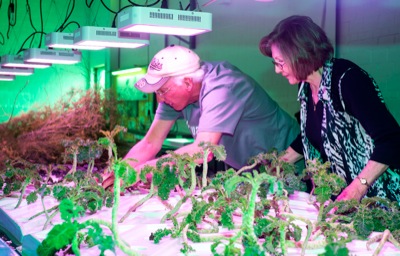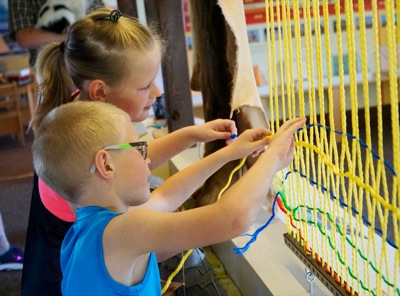Monday, May 7th, 2018
Aquaponic idea grows
Water, fish, plants used to provide healthy food for local pantry users
By William Kincaid

Photo by Mark Pummell/The Daily Standard
Terry Chapman and Charlene Huff, CALL Ministries' aquaponics system co-managers, tend to the numerous plants growing on floating trays. The plants are fed with nitrates contained in the ammonia of fish waste.
CELINA - CALL Ministries had a rather good first year with its aquaponics system launched in early 2017, raising roughly 1,200 pounds of fresh produce to supply its food pantry.
But with the addition of two new co-managers and some fine-tuning, the system is flourishing and is on track to more than double last year's output, the Rev. Tim Clutter said.
"It was a steep learning curve the first year, so we kept praying for God to send someone," he said.
The answer came by way of Charlene Huff, a master gardener, and Terry Chapman, master water/fish guy, Clutter said.
"You need the fish. You need the water. You need the bacteria. You need the plants," Clutter said about the $30,000 aquaponics system that was donated by Glynn Barber of Redkey, Indiana. "And that's the big balancing act that really when before these two (Huff and Chapman), we didn't do a very good job doing it and now with their expertise it's just raised it to a whole different level so now it's working like it should."
They are harvesting about 25 pounds of produce, chiefly lettuce, weekly.
"It's a healthy meal for the clients, and it's something in this system that grows very, very well," Clutter said of the lettuce.
Seeds are planted in sponge-like starter cubes. Once the sprouts are big enough, they graduate to the large main trough, measuring about 40 feet long and 4 feet wide, Chapman noted.
Kale, spinach, lettuce, strawberries, kohlrabi and other mostly leafy green plants are placed on floating trays over the trough, where they're fed nutrient-rich water and bathed from above with LED lights from 6 a.m. to 8 p.m. daily. The system contains 20 floating trays each with 33 separate openings for a combined capacity of 660 plants.
Officials aren't at maximum capacity yet but are steadily filling out the entire system, Chapman said.
The main trough is hooked up to a 500-gallon water tank filled with 350 yellow perch. The fish are fed twice daily and their ammonia-rich solid waste is separated. One type of bacteria converts the waste into nitrites, and another then turns the nitrites into nitrates, which are fed to the plants.
It's a self-contained ecosystem containing 1,800 gallons of water. After nourishing the plants, the water is aerated and filtered and eventually returned to the fish tank.
The yellow perch were selected for their high activity and penchant to swim together. They measured one-and-a-half inches when introduced last July into the system. Today, they measure between 6 and 8 inches and should be big enough by July to be harvested and sold.
"The goal is to sell them to someone with a farm pond," Clutter said, explaining the revenue will help offset the costs of the system.
Clutter credited the system's improved efficiency to Chapman and Huff.
"I think it was almost overwhelming," Huff said about first coming aboard in February. "For anybody that comes in and doesn't know anything about aquaponics, I felt I needed to go do some homework."
She turned to Mercer County Ohio State Extension Educator Dennis Riethman, who in turn directed her to another university expert. Clutter, Chapman and Huff also visited several other aquaponics farms.
"This is, to my knowledge, the only system like this that's completely indoors and relying upon artificial lamps. All the rest of them are in a greenhouse" Clutter said, noting other farms are commercial enterprises.
Chapman said such farms are popping up across the globe.
"It's increasing all over the world because like in countries where the weather is cold, you can grow this in a building or greenhouse year round."
"The beauty of this is it's all indoors. You don't have to get down on your hands and knees to garden. You never have to weed. It's always at least 70 degrees in this room," Clutter said.
"There are no pesticides," Huff added. "No herbicides."
To keep the plants healthier, officials plan to later add Australian redclaw crayfish into the main trough. The crayfish will then feed on the bottom and clean up any dead roots.
The crayfish will be harvested after 90 days. Clutter said the heads will be sold to an Israeli company that use a calcium deposit in the heads for cancer research and medicine.
"We'll get the claws and the tails, and I'm hoping to work with a local restaurant to have them put that on their menus," Clutter said.

Photo by Mark Pummell/The Daily Standard
Officials harvested roughly 1,200 pounds of produce last year. With a more efficient system, they hope to yield as much as 3,000 pounds this year.



